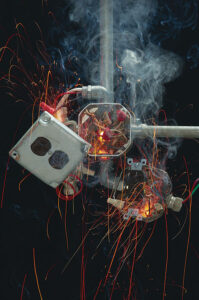
To help prevent injury and illness there are things we know we have to do to care for ourselves—especially as we get older. Our homes also have to be maintained to stay in good shape, and an important part of that maintenance includes a home’s electrical system.
According to the National Fire Protection Association (NFPA), in 2011 an estimated 47,700 home fires occurred as a result of electrical failure or malfunction. These fires resulted in 418 civilian deaths and $1.4 billion in direct property damage.
The National Association of State Fire Marshals reports that older homes are more than three times likely to have an electrical fire than newer homes. An electrical system’s insulation can eventually wear out from a variety of factors including age, animal gnawing and overloaded circuits.
Older homes were not designed for today’s electronics and appliances. According to the U.S. Department of Energy, with increasing energy consumption the electrical demands on older homes can have an impact on the household wiring. If you have an older home, you may find that you need an upgraded electric service.
The National Electric Code (NEC), published by the NFPA, provides minimum safety standards for electrical wiring installation in the U.S. and is published every three years based on the latest safety research. The NEC’s minimum standard for residential electric service is 100 amps.
“Be aware of the signs of electrical wiring problems, which include dim or flickering lights as well as a burning smell, smoke, shocks, or discoloration when using an electrical outlet or switch. Also look out for frayed wires, breakers that trip or blow, and signs of potential rodent damage that may affect insulation,” explains Mike Ashenfelter, Safe Electricity Advisory Board member. “If you suspect a problem, shut the outlet or switch off at the circuit breaker, and contact an electrician to make repairs.”
To check on the status of your home’s electrical system, contact a qualified electrician to perform an electrical inspection of your home. The U.S. Consumer Product and Safety Commission (CPSC) suggests the following timeframes for inspections:
• If the last electrical inspection of your home was 40 or more years ago—an inspection is overdue.
• If the last inspection was 10 to 40 years ago—an inspection is recommended, especially if your electrical demands have increased significantly or you have noticed any of the warning signs of an electrical problem.
• If the last inspection was less than 10 years ago—an inspection should not be needed unless you have noticed any of the warning signs of an electrical problem or any temporary wiring has been added.

The CPSC further suggests that if you are not sure when the last time your home had an electrical inspection, you might be able to find a label or tag with that information on your electrical panel door or cover. If there is no label or tag, then use the age of the house as a guide to the probable need for an inspection.
By having regular electrical system inspections, repairs, and updates, homeowners can help ensure the electrical safety of their homes. An electrical inspection can identify electrical issues that need repaired before a serious incident occurs.
To learn more about home electrical safety, visit SafeElectricity.org.








